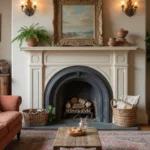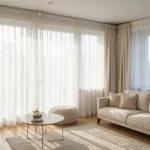Are you tired of the same old concrete or wood patio surfaces that everyone seems to have? We understand—traditional options can feel limiting when you’re trying to create an outdoor space that truly reflects your personal style and needs.
We’ve explored dozens of unique patio surface alternatives that can transform your outdoor living area into a stunning, conversation-starting extension of your home. From recycled glass pavers that sparkle in the sunlight to cork flooring that’s gentle on bare feet, these innovative materials offer both aesthetic appeal and practical benefits that concrete simply can’t match.
7 Stunning Alternatives to Traditional Concrete Patios
1. Porcelain Pavers
Porcelain pavers offer exceptional durability while mimicking the look of natural stone or wood. These low-maintenance options resist staining, scratching, and fading even in harsh weather conditions. Available in countless styles, textures, and patterns, porcelain pavers can transform your outdoor space into a sophisticated retreat. Their non-porous surface prevents moisture absorption, making them perfect for pool surroundings and areas with frequent precipitation.
2. Permeable Pavers
Environmentally conscious homeowners will appreciate permeable pavers that allow rainwater to filter through rather than run off. This eco-friendly option helps reduce erosion and replenishes groundwater supplies naturally. Many municipalities now offer incentives for installing permeable surfaces due to their positive environmental impact. These pavers come in various materials including concrete, clay, and recycled plastic configurations.
3. Artificial Grass
Modern artificial turf has evolved dramatically, creating lush, realistic-looking lawn alternatives that require virtually no maintenance. You’ll never need to mow, water, or fertilize this evergreen surface that stays perfect year-round. Artificial grass works wonderfully for play areas, pet-friendly spaces, and regions facing water restrictions. The premium varieties include advanced drainage systems and UV protection to ensure longevity.
4. Wooden Deck Tiles
Snap-together wooden deck tiles offer an easy DIY solution for covering existing concrete or creating new patio spaces. These modular pieces interlock without requiring special tools or professional installation. Tropical hardwoods like ipe and teak provide natural beauty with impressive resistance to rot and insects. Most wooden deck tiles feature built-in drainage systems that prevent water pooling and extend the life of your outdoor flooring.
5. Crushed Stone or Gravel
Natural crushed stone creates a charming, informal patio surface that drains beautifully and costs significantly less than concrete. The wide range of colors, sizes, and textures allows for customized looks from Mediterranean to modern designs. Stabilizing products can now be mixed with gravel to prevent shifting while maintaining permeability. This option proves particularly effective for drought-prone regions where water conservation matters.
6. Rubber Pavers
Recycled rubber pavers provide a soft, resilient surface that’s perfect for families with children or areas where comfort underfoot matters. Their shock-absorbing properties make falls less dangerous while their durability stands up to heavy furniture and foot traffic. Available in colors resembling brick, stone, or concrete, rubber pavers offer the aesthetics of traditional materials with superior practical benefits. These eco-friendly options repurpose used tires, keeping them out of landfills.
7. Stamped Overlays
Existing concrete patios can be transformed with stamped overlays that create the appearance of high-end materials at a fraction of the cost. These thin layers can mimic natural stone, brick, tile, or even wood grain patterns. Professional applicators use special coloring techniques to add dimension and realistic variation to the surface. Stamped overlays extend the life of your existing concrete while dramatically upgrading its appearance without the mess and expense of complete removal.
Incorporating Natural Stone for Timeless Elegance
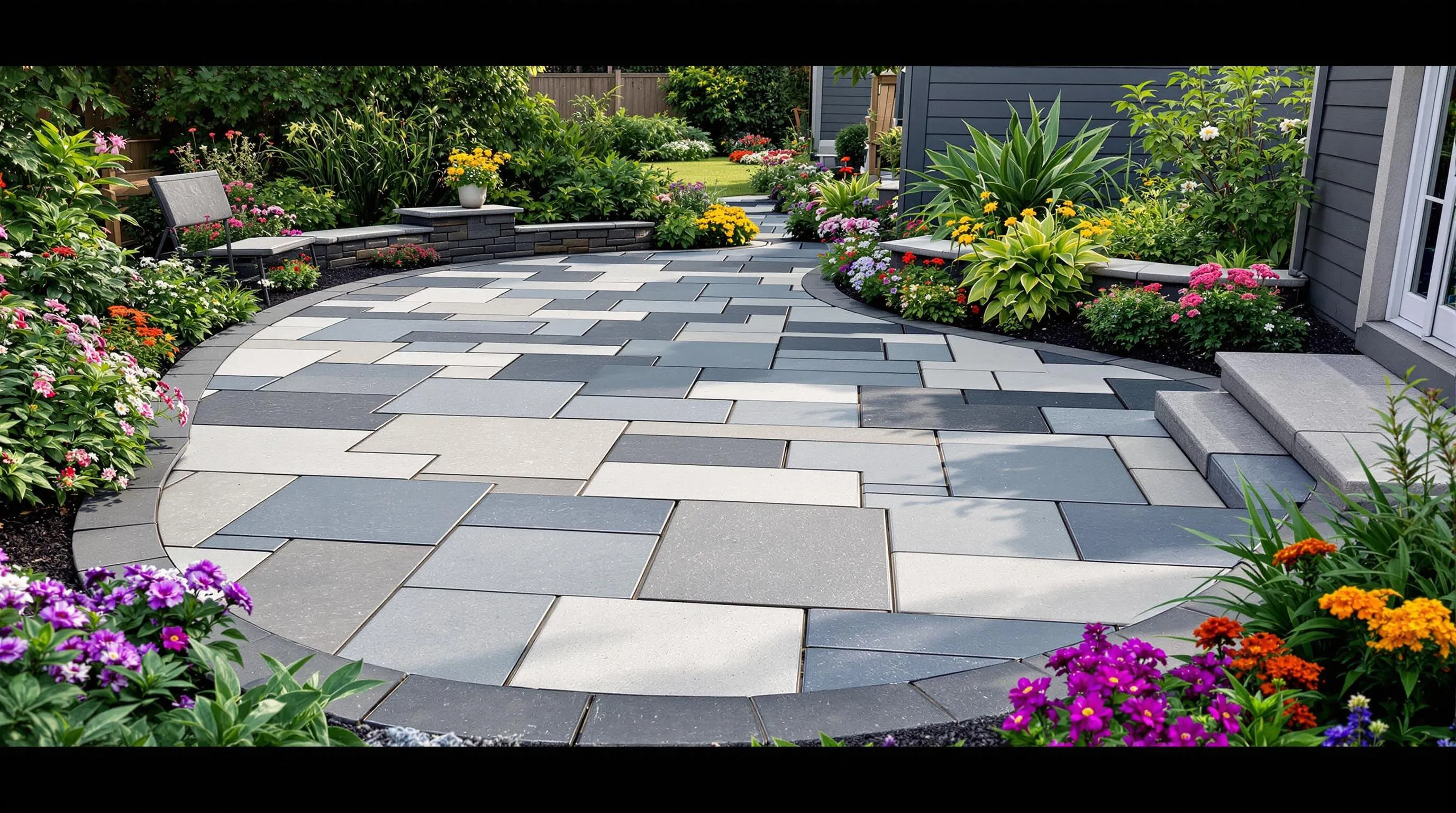
Natural stone offers unparalleled elegance and durability for outdoor spaces, creating patios that stand the test of time while maintaining their beauty. These materials bring organic texture and character that manufactured products simply cannot replicate.
Flagstone: The Versatile Classic
Flagstone stands as one of the most adaptable natural stone options for patio surfaces, composed primarily of sedimentary rock containing quartz, feldspar, and various minerals. We love how this material can be arranged in countless patterns, from formal geometric layouts to free-form mosaic designs that showcase each stone’s unique shape and character. Its naturally textured surface provides excellent slip resistance even when wet, making it a safe choice for pool surroundings and areas with high precipitation.
Homeowners appreciate flagstone’s remarkable durability, with properly installed patios often lasting decades with minimal maintenance requirements. Though the initial investment may be higher than conventional patio materials, its longevity and timeless appeal offer exceptional long-term value. One consideration to keep in mind is that flagstone’s weight necessitates proper base preparation and may require professional installation for optimal results. Applying a quality sealer every few years will enhance its natural colors and protect against staining from outdoor elements.
Slate: Dramatic Color Variations for Modern Spaces
Slate delivers sophisticated drama to contemporary outdoor spaces with its striking color palette ranging from deep charcoals and blacks to blues, greens, and purples. This metamorphic rock features a naturally smooth texture that complements modern architectural styles perfectly. Designers frequently choose slate for its uniform thickness and relatively flat surface, creating clean lines that define sleek, minimalist patio designs.
Homeowners seeking low-maintenance options will appreciate slate’s natural resistance to stains and its ability to withstand harsh weather conditions without fading. The material’s density makes it exceptionally durable against impacts and heavy furniture, ensuring your patio remains pristine for years. Water resistance ranks among slate’s strongest attributes, though this same quality can make it potentially slippery when wet—consider adding texture during installation for high-traffic or wet areas. While premium slate represents a important investment, its stunning appearance and exceptional longevity justify the cost for those creating truly distinctive outdoor living spaces.
Embracing Wooden Deck Alternatives
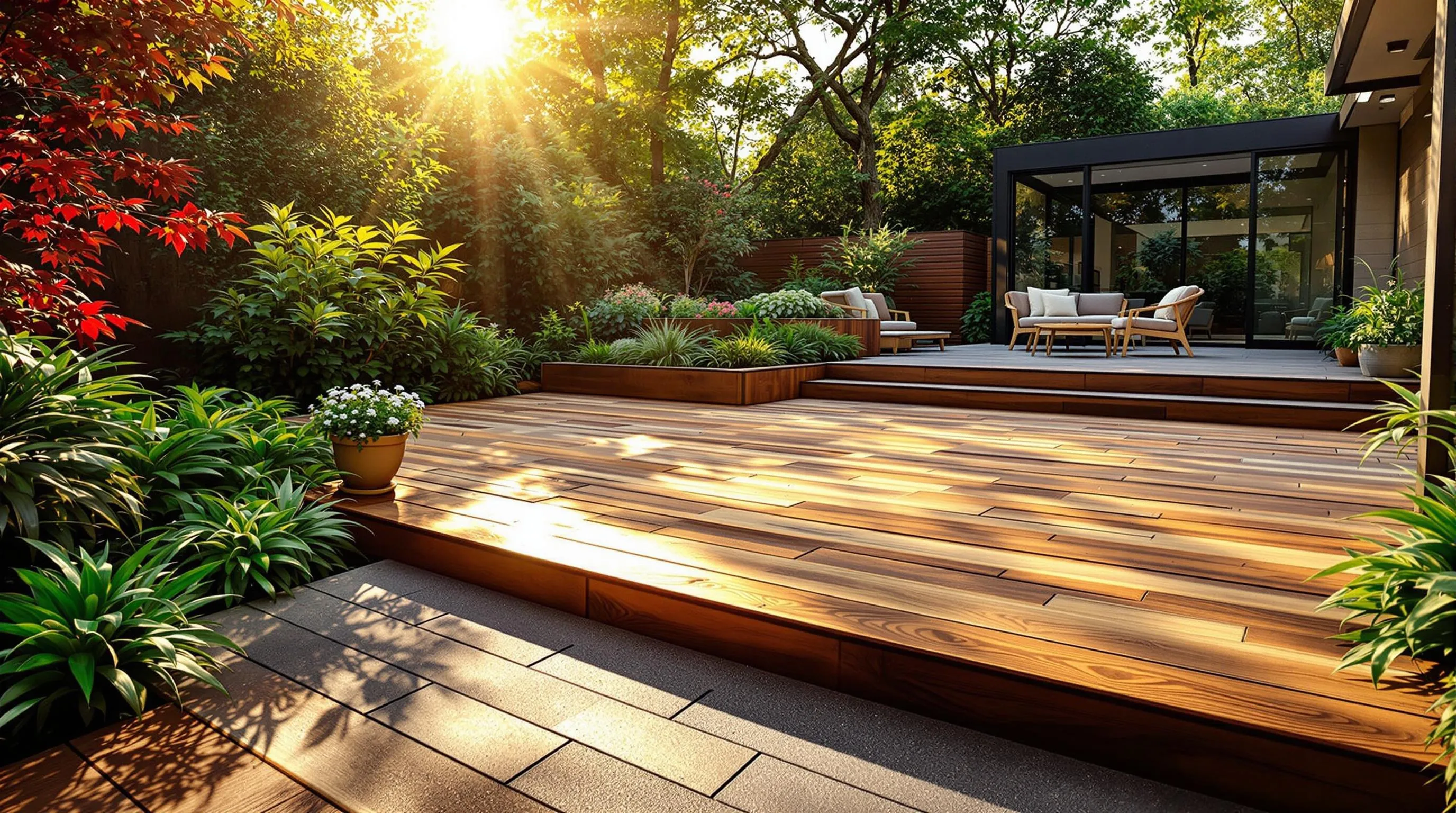
While traditional wooden decks have their charm, innovative alternatives offer unique benefits worth considering for your outdoor space.
Reclaimed Timber: Eco-Friendly Character
Reclaimed timber transforms your patio into a story-rich outdoor retreat with its distinctive weathered textures. This sustainable option sources wood from discarded materials like old barns and pallets, significantly reducing landfill waste while adding rustic appeal to your outdoor living area. The natural aging process of reclaimed timber creates unique character marks and patina that new lumber simply cannot replicate. You’ll appreciate both the environmental benefits and the conversation-starting appeal when guests visit your distinctive patio. Proper sealing remains important for these materials to prevent potential rot or insect damage, ensuring your eco-conscious choice stands the test of time.
Composite Decking: Low-Maintenance Luxury
Composite decking offers the perfect balance between natural wood aesthetics and modern durability for busy homeowners. Made from recycled plastics and wood fibers, this innovative material requires minimal upkeep compared to traditional wooden decks that demand regular staining and sealing. Your composite deck will resist moisture damage, splintering, and UV fading, maintaining its appearance for years with simple occasional cleaning. Modern composite options come in various colors and textures that convincingly mimic natural wood grain without the maintenance headaches. The material performs exceptionally well in contemporary design schemes, though homeowners should note it can retain heat when placed in direct sunlight – something to consider for particularly sunny patio locations.
Exploring Permeable Paving Options
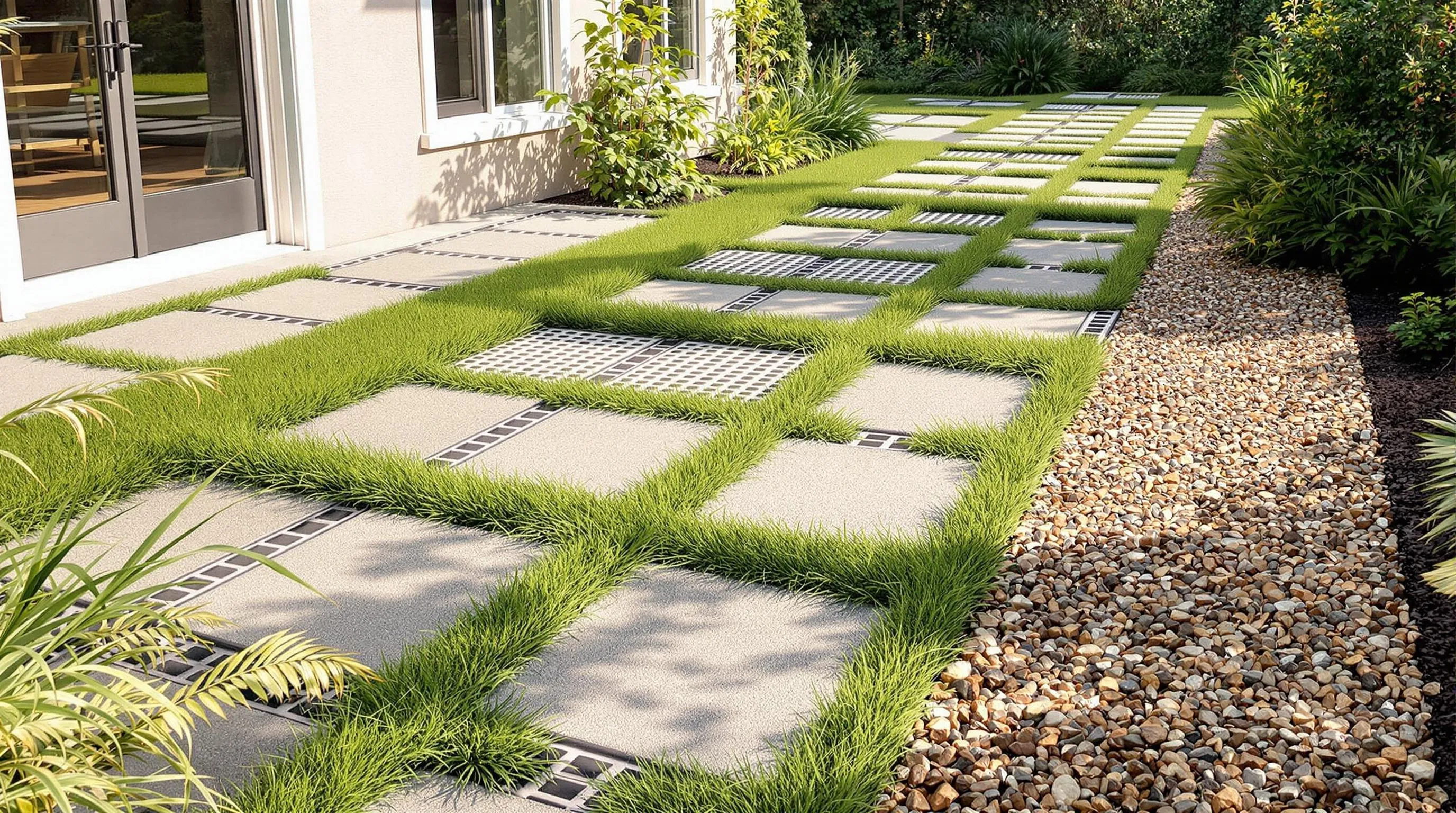
When designing an eco-friendly patio, permeable paving options offer the perfect balance between functionality and environmental responsibility. These innovative surfaces allow water to filter through to the soil beneath, reducing runoff and supporting healthier ecosystems.
TRUEGRID Pavers: Eco-Friendly Durability
TRUEGRID Pavers represent a revolutionary approach to permeable paving, manufactured from 100% recycled plastic materials. Their ingenious design allows stormwater to drain directly into the soil, effectively reducing runoff while maintaining optimal soil health beneath your patio. These pavers deliver exceptional durability even under regular use, standing up to various weather conditions without deterioration. Maintenance requirements remain minimal throughout their lifespan, making them an excellent long-term investment for environmentally conscious homeowners. The installation process is relatively straightforward, creating a stable surface that combines sustainability with practical performance.
Grass Pavers: Blending Hardscape with Nature
Grass pavers offer an innovative solution that beautifully merges the structural integrity of traditional pavers with the lush appearance of a natural lawn. Their unique design provides adequate support for light vehicle traffic while maintaining a predominantly green visual appeal across your patio area. The environmental benefits of this option are substantial, as the grass sections help reduce urban heat island effects that plague conventional hardscaping materials. These pavers promote healthy turf growth by protecting grass roots while allowing necessary water permeation. The resulting surface creates a visually striking transition between hardscaped areas and surrounding industry features, softening the overall appearance of your outdoor living space.
Gravel and Crushed Stone: Budget-Friendly Beauty
Gravel delivers an instantly charming, rustic aesthetic that complements various industry styles without breaking your budget. Installation costs remain significantly lower than many alternative paving options, requiring minimal specialized equipment or expertise. The excellent drainage properties of gravel make it particularly suitable for areas prone to water accumulation or flooding concerns. But, walking comfort can be compromised on gravel surfaces, especially for those wearing thin-soled shoes or with mobility challenges. Regular replenishment becomes necessary as the material tends to scatter and settle over time with consistent use.
Crushed stone shares many advantages with gravel, providing a naturally appealing surface at an affordable price point. Various stone types offer different visual characteristics, allowing you to customize the look to complement your home’s exterior aesthetic. Crushed limestone represents a particularly practical option, as it can create a surprisingly solid, compacted surface when applied in sufficient depth. The installation process involves minimal complexity, making it accessible for DIY enthusiasts looking to transform their outdoor spaces without professional assistance. Both gravel and crushed stone deliver excellent permeability, allowing rainwater to naturally filter into the ground rather than contributing to harmful runoff.
Installing Unique Tile Patterns for Visual Impact
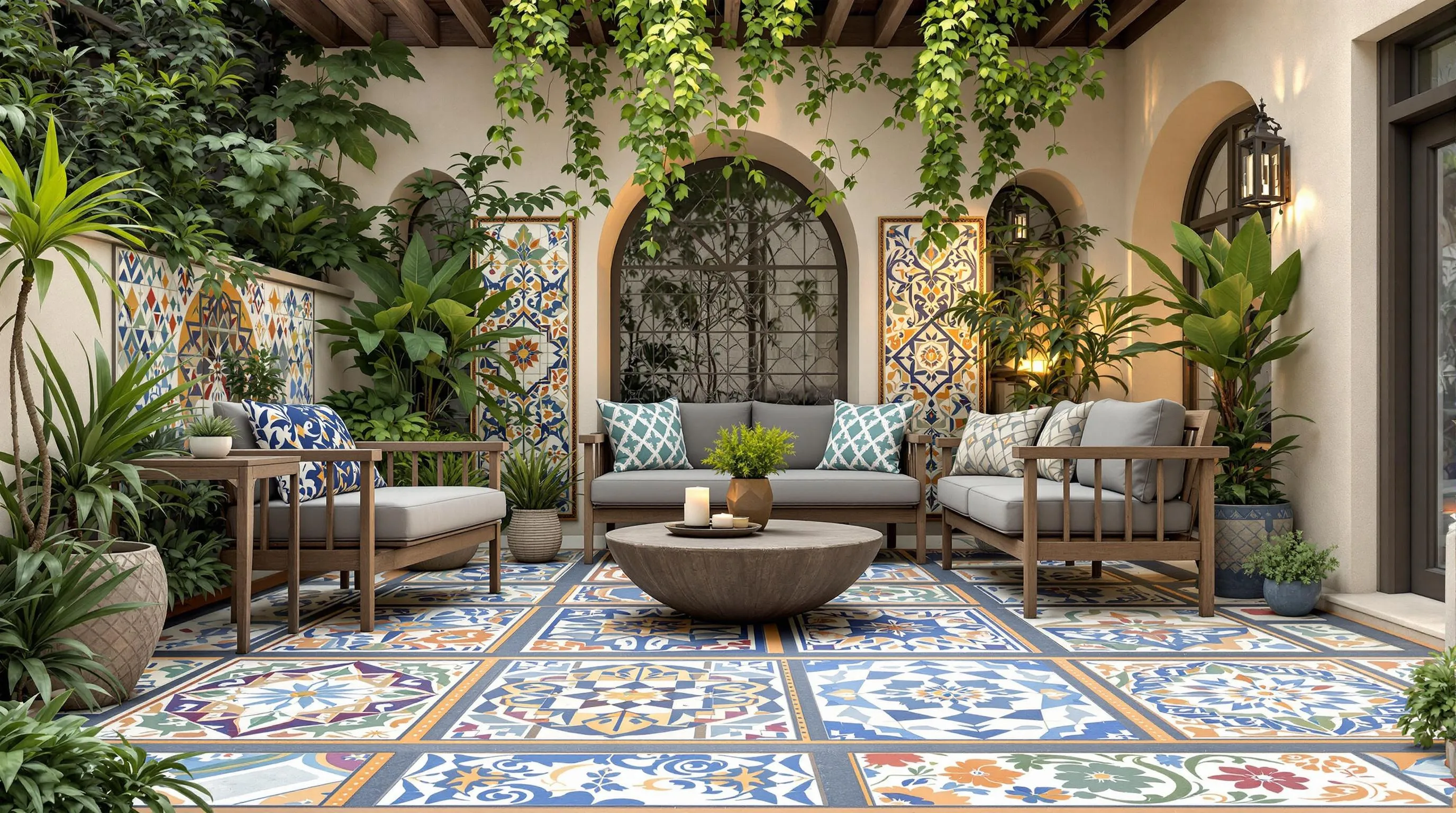
Creating a patio that stands out requires thinking beyond ordinary surfaces. Unique tile patterns can transform your outdoor space into a visual masterpiece that reflects your personal style while providing durability and function.
Mosaic Tiling for Custom Designs
Mosaic tiling offers endless possibilities for creating truly one-of-a-kind patio surfaces. Using broken glass, ceramic shards, or stone pieces, you can create intricate designs that become the centerpiece of your outdoor area. These materials are typically set into a wet concrete base, allowing for complete creative freedom in pattern and color. The finished result isn’t just beautiful—it’s a personal artistic statement that can’t be replicated.
Stamped concrete provides another avenue for adding visual interest through patterns. This technique mimics premium materials like slate or wood through textured impressions, giving you the look of expensive materials with greater durability and lower maintenance requirements than natural stone.
For a touch of Mediterranean charm, traditional clay or terracotta tiles deliver vibrant, warm aesthetics. These tiles work particularly well with Spanish-style homes, creating an authentic outdoor atmosphere that feels both timeless and inviting.
Porcelain Pavers: Weather-Resistant and Stylish
Porcelain pavers have become increasingly popular for patios due to their exceptional durability in extreme weather conditions. These sophisticated tiles resist moisture penetration, staining, and UV damage, making them ideal for areas experiencing both freezing winters and scorching summers. Their non-porous nature prevents water absorption, significantly reducing the risk of cracking during freeze-thaw cycles.
Style doesn’t take a backseat to function with porcelain pavers. Available in many finishes including convincing wood-look and stone-look options, these versatile tiles cater to modern design preferences while offering practical benefits. Their slip-resistant surfaces enhance safety, especially important for pool deck areas or regions with frequent rainfall.
Installation typically involves a compacted gravel base for stability and proper drainage. While DIY installation is possible, professional laying often yields better long-term results due to the precise leveling required for these premium materials.
Moroccan Tiles: Bold Patterns for Statement Patios
For homeowners seeking to make a bold statement, hand-painted Moroccan tiles (known as Zellige) deliver unmatched visual impact. These tiles feature distinctive geometric patterns in vibrant hues such as cobalt blue, emerald green, and rich terracotta. Each tile contributes to an intricate overall design that becomes the focal point of any outdoor space.
Moroccan tiles typically feature a protective glaze that enhances their weather resistance, making them suitable for outdoor use when properly installed. The tiles are paired with appropriate grout to prevent cracking and maintain their integrity through seasonal changes.
For maximum impact without overwhelming the space, consider using these statement tiles as accents around key features like fire pits, fountains, or outdoor dining areas. This strategic placement creates zones of visual interest while infusing your patio with cultural flair and artistic sophistication.
Considering Eco-Friendly Rubber Surfacing

For homeowners seeking sustainable alternatives to traditional patio materials, eco-friendly rubber options provide both environmental benefits and practical advantages for outdoor spaces.
Recycled Rubber Pavers: Comfort Underfoot
Recycled rubber pavers transform discarded tires into durable, cushioned surfaces perfect for patios and outdoor living areas. These innovative pavers offer exceptional slip resistance even when wet, making them safer than many traditional materials. The inherent flexibility of rubber creates a surface that’s noticeably comfortable underfoot, reducing fatigue during long periods of standing. Unlike concrete, these pavers withstand extreme temperature fluctuations without cracking or deteriorating, ensuring long-term performance in various climates. Water permeability is another major advantage, as these pavers allow rainfall to drain through the surface rather than creating runoff. Installation requires minimal specialized equipment, making recycled rubber pavers an accessible DIY project for many homeowners. Their eco-friendly composition diverts thousands of tires from landfills annually, contributing to environmental sustainability while creating functional outdoor spaces.
Pour-in-Place Rubber: Seamless Installation
Pour-in-Place rubber surfacing elevates patio design with its completely seamless appearance, eliminating the gaps and seams found in traditional pavers. This innovative system combines rubber granules with binding agents to create a continuous, shock-absorbent surface that’s particularly beneficial for areas where children play. The installation process requires professional expertise to achieve optimal results, ensuring proper curing and adhesion across the entire patio area. Without joints or spaces between materials, weeds have no opportunity to grow through the surface, significantly reducing maintenance requirements compared to conventional paving options. The smooth, uninterrupted surface also eliminates potential tripping hazards that can occur with shifting pavers or uneven surfaces. Pour-in-Place rubber maintains its resilience in varying weather conditions, resisting degradation from UV exposure and moisture. Available in many colors and patterns, this versatile surfacing option allows homeowners to customize their outdoor spaces while enjoying the environmental benefits of recycled materials.
Creating Living Patios with Alternative Greenery
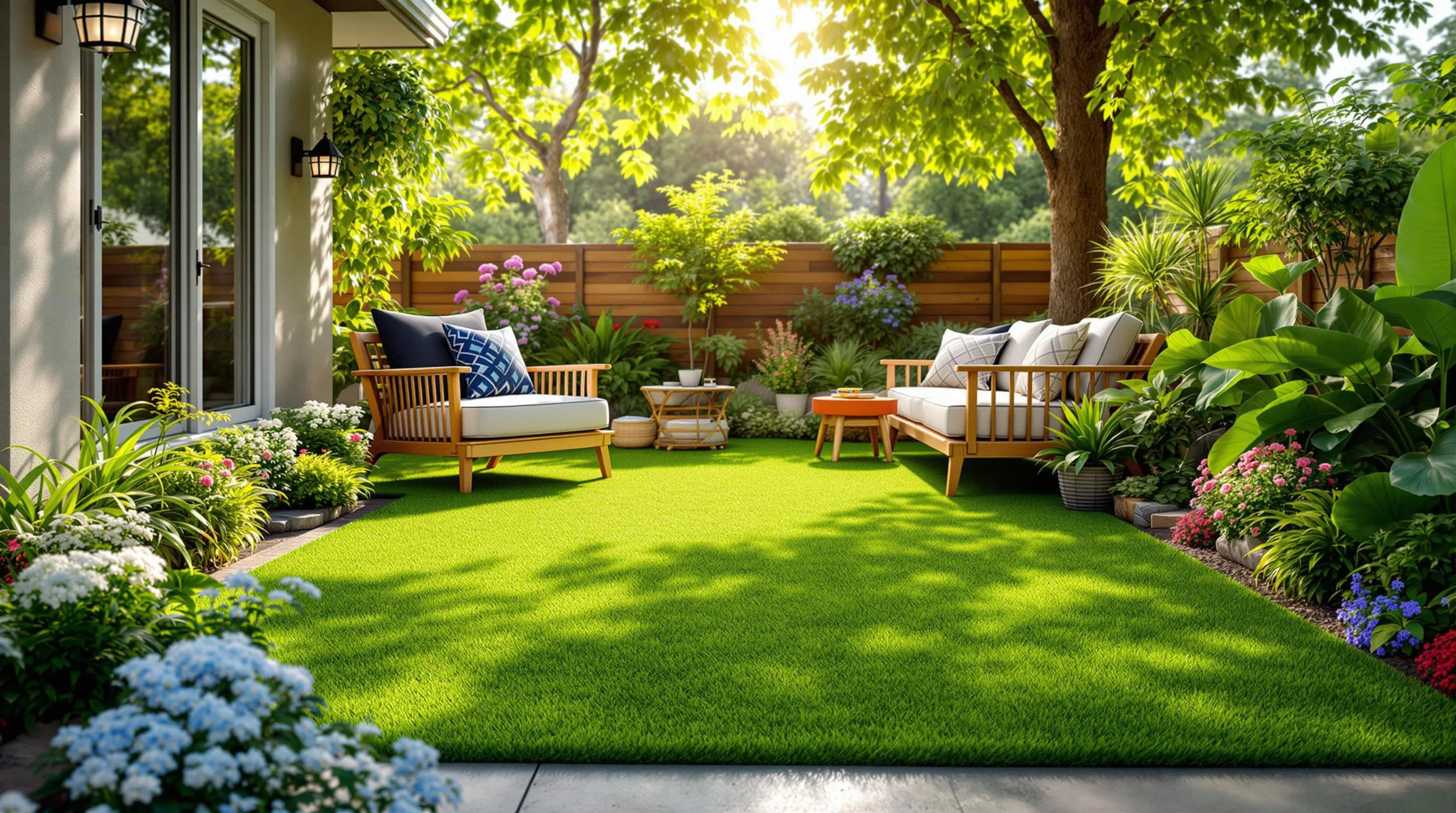
Looking beyond traditional hardscapes, living patio surfaces offer a refreshing approach to outdoor spaces, combining functionality with natural beauty. These green alternatives bring life to your patio while providing unique environmental benefits.
Clover Lawns: Low-Maintenance Ground Cover
Clover lawns stand out as exceptional drought-tolerant ground cover options that require minimal upkeep compared to traditional turf. White clover (Trifolium repens) offers remarkable resilience to foot traffic, making it ideal for areas where people gather and walk regularly. You’ll appreciate how clover thrives in poor soil conditions without needing fertilization, as it naturally fixes nitrogen into the soil. This self-sustaining characteristic eliminates the need for chemical amendments commonly used on grass lawns. Homeowners enjoy the soft texture underfoot, creating a comfortable surface for barefoot strolls during warmer months. Seasonal blooms add visual interest to your outdoor space while attracting beneficial pollinators. We recommend clover for homeowners seeking a low-maintenance alternative that needs infrequent mowing and provides year-round greenery with ecological benefits.
Moss Gardens: Lush, Carpet-Like Surfaces
Moss gardens transform shaded patio areas into lush, evergreen carpets with distinctive visual appeal and texture. Species like sheet moss (Hypnum) and haircap moss (Polytrichum) create natural, velvety surfaces in areas that receive minimal direct sunlight. These varieties flourish in acidic soil conditions with consistent moisture, making them perfect for naturally shaded locations or north-facing patio sections. Moss completely eliminates mowing requirements, offering a truly maintenance-free surface once established. Garden enthusiasts value moss for its year-round color and ability to thrive where grass struggles. Proper moisture management remains essential, as moss requires controlled watering practices to maintain its vibrant appearance. Shade management also plays a crucial role in moss garden success, so selecting locations with filtered light or dappled shade provides optimal growing conditions. Moss creates an enchanting, woodland-inspired aesthetic that works beautifully around stepping stones or as a full patio surface in appropriate locations.
Maintaining Your Unique Patio Surface for Years of Enjoyment
Transforming your outdoor space with these alternative patio surfaces opens up a industry of design possibilities beyond traditional concrete. Whether you’re drawn to the eco-friendly benefits of recycled rubber pavers the natural elegance of flagstone or the living beauty of clover lawns these unique options deliver both aesthetic appeal and practical functionality.
We’ve explored materials that reduce environmental impact provide better drainage and require less maintenance while creating truly personalized outdoor living areas. The right choice depends on your exact needs climate and design preferences.
Remember that proper installation and regular maintenance will maximize the lifespan of your chosen surface. With these innovative alternatives your patio can become the standout feature of your property reflecting your personal style while solving common problems associated with conventional materials.
Frequently Asked Questions
What are the best alternatives to concrete patios?
The best alternatives include porcelain pavers, permeable pavers, artificial grass, snap-together wooden deck tiles, crushed stone/gravel, rubber pavers, and stamped overlays. Natural stone options like flagstone and slate offer timeless elegance, while reclaimed timber and composite decking provide wooden alternatives. For eco-conscious homeowners, recycled glass pavers, TRUEGRID permeable pavers, and living surfaces like clover lawns are excellent choices.
Are permeable pavers better for the environment?
Yes, permeable pavers are significantly better for the environment. They allow stormwater to drain directly into the soil rather than creating runoff, which helps replenish groundwater and reduces flooding risks. Options like TRUEGRID Pavers (made from 100% recycled plastic) and grass pavers promote soil health while providing functional surfaces. This permeability also helps filter pollutants before they enter waterways.
How durable are porcelain pavers compared to concrete?
Porcelain pavers are exceptionally durable, often outlasting concrete in residential applications. They resist staining, scratching, fading, and frost damage better than concrete while requiring minimal maintenance. With proper installation, porcelain pavers can maintain their appearance for decades without the cracking issues common with concrete. They also offer superior slip resistance and don’t absorb moisture, preventing mold and mildew growth.
What is the most budget-friendly patio alternative?
Gravel and crushed stone are the most budget-friendly alternatives to traditional patios. These materials cost significantly less than concrete, pavers, or decking options while providing excellent drainage and a naturally attractive appearance. Crushed limestone can create a surprisingly solid surface when properly installed. DIY installation is relatively simple, further reducing costs, and these materials can be easily refreshed or replenished as needed.
Are rubber pavers suitable for hot climates?
Rubber pavers are suitable for hot climates with some considerations. They withstand extreme temperature fluctuations better than many alternatives and typically stay cooler than concrete or stone. However, dark-colored rubber pavers can absorb heat, so lighter colors are recommended for very hot regions. The material’s excellent drainage prevents water buildup, and its cushioned surface remains comfortable underfoot even in high temperatures.
How difficult is it to install wooden deck tiles?
Installing snap-together wooden deck tiles is one of the easiest DIY patio projects available. These interlocking tiles require no special tools or skills—they simply click together over any flat surface, including existing concrete. Most systems allow for cutting tiles to fit around obstacles. A typical patio can be transformed in a single afternoon, making this an ideal weekend project for homeowners seeking quick improvements without professional installation.
What maintenance do natural stone patios require?
Natural stone patios require moderate maintenance to preserve their beauty. Regular sweeping prevents debris accumulation, while occasional rinsing removes dirt. Depending on the stone type, sealing every 1-3 years protects against staining and moisture damage. Flagstone and slate may need repointing (replacing mortar) every few years if installed with mortar joints. Promptly addressing spills and avoiding harsh chemicals will extend the life of natural stone surfaces.
Can living patio surfaces withstand regular foot traffic?
Yes, certain living patio surfaces can withstand regular foot traffic. Clover lawns are particularly resilient, handling moderate foot traffic better than traditional grass while requiring less water and maintenance. Moss gardens are better suited for light to moderate traffic areas. For heavier use, consider grass pavers that combine vegetation with structural support. These living surfaces recover more easily from wear and create cooler, more comfortable walking surfaces than hard materials.
How long do composite decking materials typically last?
Composite decking typically lasts 25-30 years with minimal maintenance, significantly outlasting traditional wood decking’s 10-15 year lifespan. Many manufacturers offer warranties ranging from 25 years to lifetime coverage against structural damage, fading, and staining. Unlike wood, composite materials won’t splinter, crack, or rot. Regular cleaning with soap and water is usually sufficient to maintain appearance, with no need for sanding, staining, or sealing.
Which patio surface is best for areas with freezing winters?
Porcelain pavers and rubber surfaces excel in freezing climates. Porcelain’s extremely low water absorption rate (less than 0.5%) prevents freeze-thaw damage that cracks concrete and natural stone. Rubber pavers remain flexible even in extreme cold, adapting to ground movement without cracking. Both materials provide better traction than concrete when wet or icy. For wooden options, composite decking outperforms natural wood in freezing conditions as it resists moisture-related expansion and contraction.









